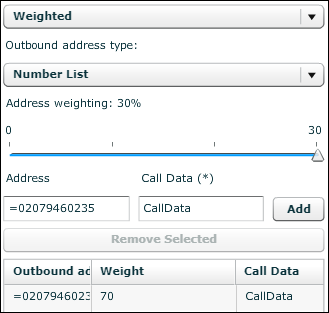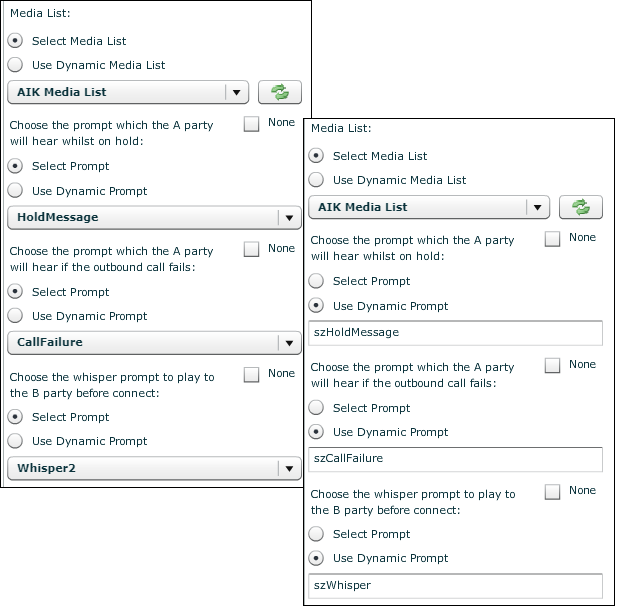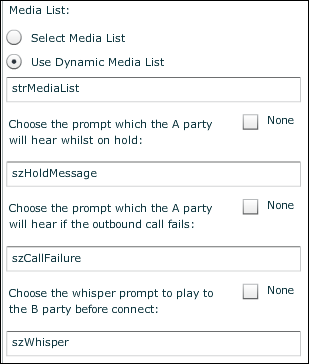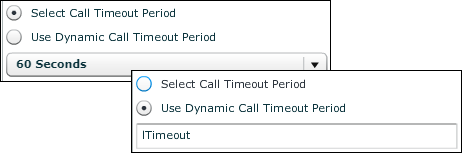Routes incoming calls to destination telephone numbers.
|
Routes incoming calls to destination telephone numbers. |

Use this to route a calls to a single number or to list of numbers that are tried randomly, sequentially or according to a weighting. You can build a list of numbers directly in the action cell or you can use a preconfigured delivery point destination or delivery point group of destinations. (Delivery points are configured in the storm Admin Portal. See the Admin Portal User Guide for details.)
You can also use the action cell to route calls to a third-party call centre or to a custom service. This requires a bespoke project to create the custom service. The calls are placed in a queue and forwarded to the call centre in the order in which they were received. The queue can be set up using storm PBX/CONTACT (see the PBX and CONTACT Configuration Guide for details) or it can be created automatically by the FLOW script.
This is for defining the call destination(s).
Number selection type
Select 'sequential', 'random', or 'weighted'.
Outbound address type
Select 'Number List' to build the list in the action cell. Or, select 'Delivery Point List' to use a preconfigured delivery point or delivery point group. A delivery point may be capped at a maximum number of simultaneous calls, typically corresponding to the number of agents who can take calls at that location. When allocating calls to delivery points, the system will call the first delivery point until the maximum number of simultaneous calls for that number is reached, and then proceed to the next in the list.
For a 'sequential or 'random' selection type, enter a number to route to in the Address field (or select a delivery point/group). The Call Data field optionally allows you to capture data for a call. To do this, populate the field with a local variable based on the Call Data system variable. Click Add to add the entry to the list below.
For a 'weighted' selection type, use the slider to select a percentage weighting for the number you are adding. A number assigned a 50% weighting will be tried twice as often as one assigned a 25% weighting, for example. The scale maximum reflects the percentage weight remaining as you add numbers.

This is for configuring the audio prompts to play to the calling party (A-party) and called party (B-party) as the call is routed.
Media List/prompts
Use the Select Media List option to select the media list containing the audio files to use for the audio prompts. Then, either use the Select Prompt options lists to select the files or use the Use Dynamic Prompt options to use local string variables containing the names of the files. You can select a None check box to play a system default prompt instead of your own.

Alternatively, use the Use Dynamic Media List option to use a local string variable containing the name of the media list and then use a local string variable containing the name of the file in the media list.

This is for defining general call-handling settings.
Select Call Timeout Period/Use Dynamic Call Timeout Period
Specify the period after which the service should deem the call routing attempt to have failed or the period after which it should attempt the next number in the list, if present.
Select a value or enter an integer or a float variable.

Note: the Maximum Queueing Time value, if present, overrides this value (see later). For multiple numbers, calls will queue on each number for the specified timeout duration before moving onto the next.
Set Origination Number
Select the number to show to the called party.
Record Call
Select this to record calls.
End Call if Recording Fails
Select this if call recording is required for regulatory reasons.
Enable DTMF Exit
Select this to allow the called party to route the call back to the script by pressing a key (these are configured on the action cell's exit points).
Enable Call Queueing
Select this to place a call in a first-in, first-out queue when the attempted outbound number is busy. The system will keep trying to route the call until the line becomes free. You can use this when routing calls to a third-party call centre.
You can set the Maximum Queueing Time for each call after which it will follow the action cell’s exit route for failed calls or tries the next number in the list. This timeout overrides the call timeout period, and must be greater than 5 seconds. Either select a static value or specify a variable value.
Select Anonymous Queue
Select this to select a queue configured in storm PBX/CONTACT instead of the system queue that is set up automatically.
Enable Queue Hold Script
Available if you have a custom script configured by Content Guru
Select this to use the custom script. Contact your local support representative for advice on how to configure the displayed fields.
This is for defining a custom service to run on call connection.
Enable Connected Call Script
Select this to enable the tab's properties.
Select the required service from the first options list, and the name of the application from the second.
Input Variables
Use this section to build a list of variables to pass to the custom service. In the Name field, enter the name of the variable as recognised by the service (use a literal value prefixed by =, or a string variable). In the Value field, provide the value to pass. Click Add to add the Name/Value pair to the list below.
Output Variables
Use this section to build a list of variables that are returned from the custom service.
|
Exit point |
Taken |
|
Success |
When a successful call ends. |
|
Failure |
When all attempts to route the call have failed. |
|
B Party Key Press |
Enabled only if the Enable DTMF Exit option is enable on the Call Options tab When the called party presses the configured key(s). |
|
Error |
If the prompt to re-record or any media files configured on the Media tab could not be located. |